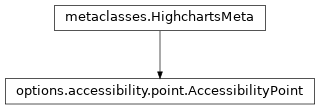.point
class: AccessibilityPoint
- class AccessibilityPoint(**kwargs)[source]
Options for describing individual points.
Class Inheritance

- copy(other=None, overwrite=True, **kwargs)
Copy the configuration settings from this instance to the
otherinstance.- Parameters:
other (
HighchartsMeta) – The target instance to which the properties of this instance should be copied. IfNone, will create a new instance and populate it with properties copied fromself. Defaults toNone.overwrite (
bool) – ifTrue, properties inotherthat are already set will be overwritten by their counterparts inself. Defaults toTrue.kwargs – Additional keyword arguments. Some special descendents of
HighchartsMetamay have special implementations of this method which rely on additional keyword arguments.
- Returns:
A mutated version of
otherwith new property values
- classmethod from_dict(as_dict: dict, allow_snake_case: bool = True)
Construct an instance of the class from a
dictobject.
- classmethod from_js_literal(as_str_or_file, allow_snake_case: bool = True, _break_loop_on_failure: bool = False)
Return a Python object representation of a Highcharts JavaScript object literal.
- Parameters:
as_str_or_file (
str) – The JavaScript object literal, represented either as astror as a filename which contains the JS object literal.allow_snake_case (
bool) – IfTrue, interpretssnake_casekeys as equivalent tocamelCasekeys. Defaults toTrue._break_loop_on_failure (
bool) – IfTrue, will break any looping operations in the event of a failure. Otherwise, will attempt to repair the failure. Defaults toFalse.
- Returns:
A Python object representation of the Highcharts JavaScript object literal.
- Return type:
HighchartsMeta
- classmethod from_json(as_json_or_file, allow_snake_case: bool = True)
Construct an instance of the class from a JSON string.
- Parameters:
as_json_or_file – The JSON string for the object or the filename of a file that contains the JSON string.
allow_snake_case (
bool) – IfTrue, interpretssnake_casekeys as equivalent tocamelCasekeys. Defaults toTrue.
- Returns:
A Python objcet representation of
as_json.- Return type:
HighchartsMeta
- to_dict() dict
Generate a
dictrepresentation of the object compatible with the Highcharts JavaScript library.Note
The
dictrepresentation has a property structure and naming convention that is intentionally consistent with the Highcharts JavaScript library. This is not Pythonic, but it makes managing the interplay between the two languages much, much simpler.
- to_js_literal(filename=None, encoding='utf-8') str | None
Return the object represented as a
strcontaining the JavaScript object literal.
- to_json(filename=None, encoding='utf-8')
Generate a JSON string/byte string representation of the object compatible with the Highcharts JavaScript library.
Note
This method will either return a standard
stror abytesobject depending on the JSON serialization library you are using. For example, if your environment has orjson, the result will be abytesrepresentation of the string.- Parameters:
- Returns:
A JSON representation of the object compatible with the Highcharts library.
- Return type:
- static trim_dict(untrimmed: dict, to_json: bool = False) dict
Remove keys from
untrimmedwhose values areNoneand convert values that have.to_dict()methods.
- static trim_iterable(untrimmed, to_json=False)
Convert any
EnforcedNullTypevalues inuntrimmedto'null'.
- property date_format: str | None
Date format to use for points on datetime axes when describing them to screen reader users.
Defaults to the same format as in tooltip.
See also
Detailed documentation on supported format replacement codes: https://api.highcharts.com/class-reference/Highcharts.Time#dateFormat
- property date_formatter: CallbackFunction | None
JavaScript formatter function to determine the date/time format used with points on datetime axes when describing them to screen reader users.
The formatter function should receive one argument,
point, referring to the point to describe. Should return a date format string compatible withAccessibilityPoint.date_format().- Returns:
Formatter function to determine date/time format used.
- Return type:
CallbackFunctionorNone
- property describe_null: bool | None
If
True, will describe points with the valuenullto assistive technology (e.g. screen readers).Defaults to
True.
- property description_formatter: CallbackFunction | None
JavaScript formatter function to use instead of the default for point descriptions.
The JavaScript formatter function should receive one argument,
point, referring to the point to describe. Should return a string with the description of the point for a screen reader user. Iffalseis returned, the default formatter will be used for that point.Tip
Best practice is to use
Accessibility.value_description_format()instead if possible, as default functionality such as describing annotations will be preserved.- Returns:
The JavaScript formatter function to use for point descriptions.
- Return type:
CallbackFunctionorNone
- property value_decimals: int | None
Number of digits after the decimal point to use for the values in the point description. Uses
Tooltip.value_decimals()if not provided here.- Returns:
Number of digits to use after the decimal point.
- Return type:
- Raises:
ValueError – if a negative number is provided
- property value_description_format: str | None
Format to use for describing the values of data points to assistive technology - including screen readers. The point context is available as
{{point}}.Defaults to
{xDescription}{separator}{value}Other available context variables include
{{index}},{{value}}, and{{xDescription}}.Note
Additionally, the series name, annotation info, and description added in
Point.accessibility.description()is added by default if relevant. To override this, use theAccessibilityPoint.description_formatter()option.